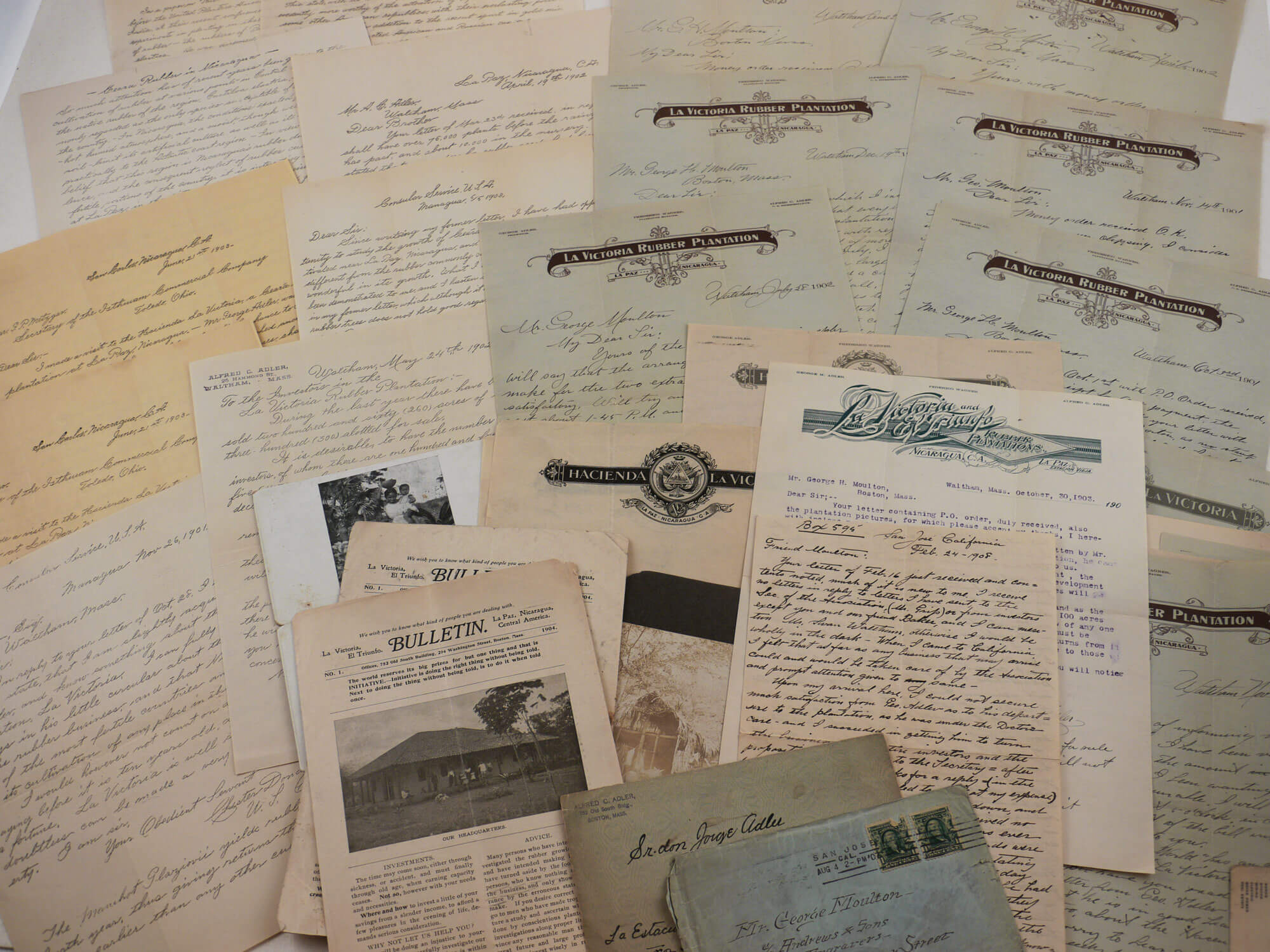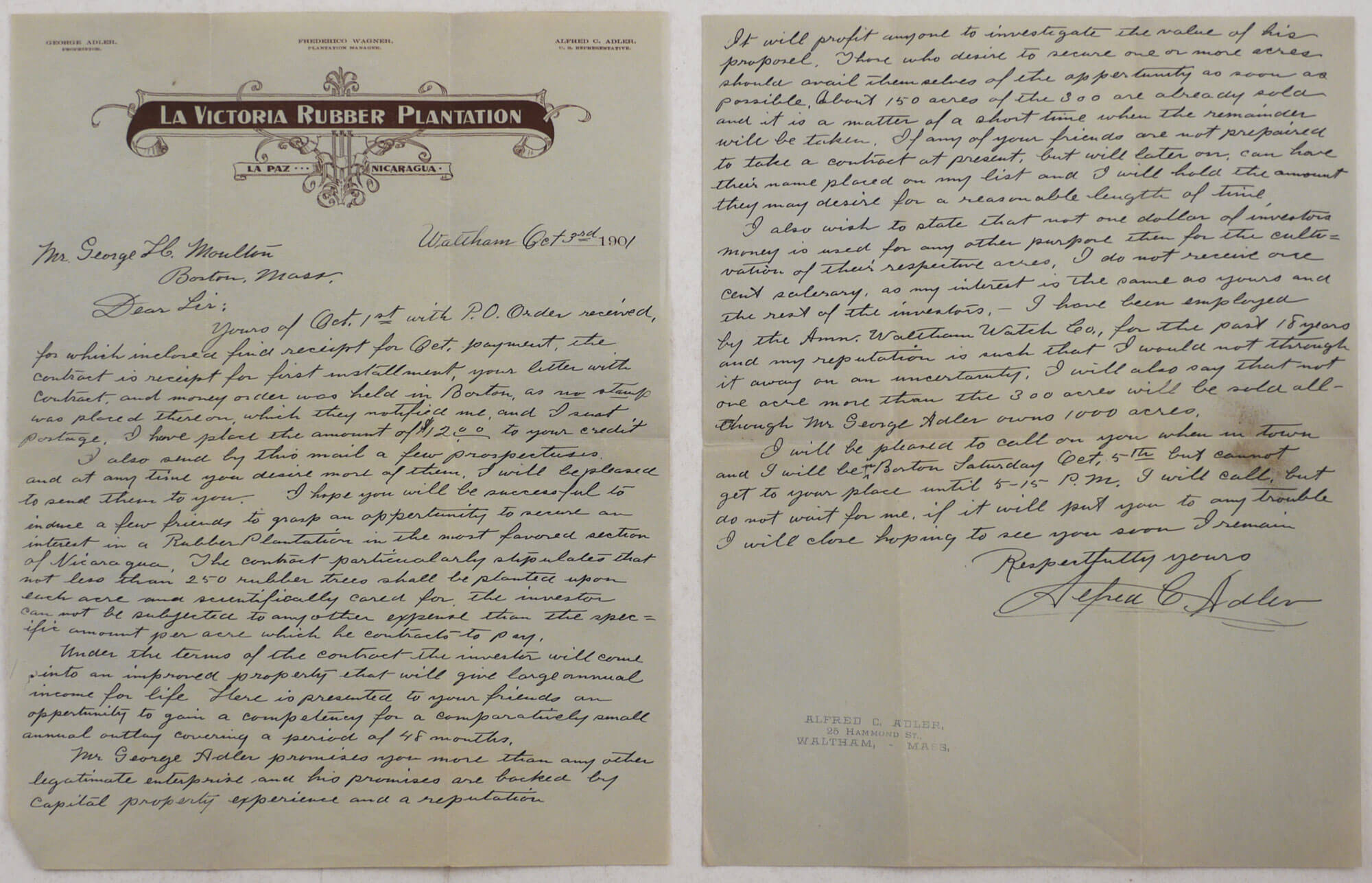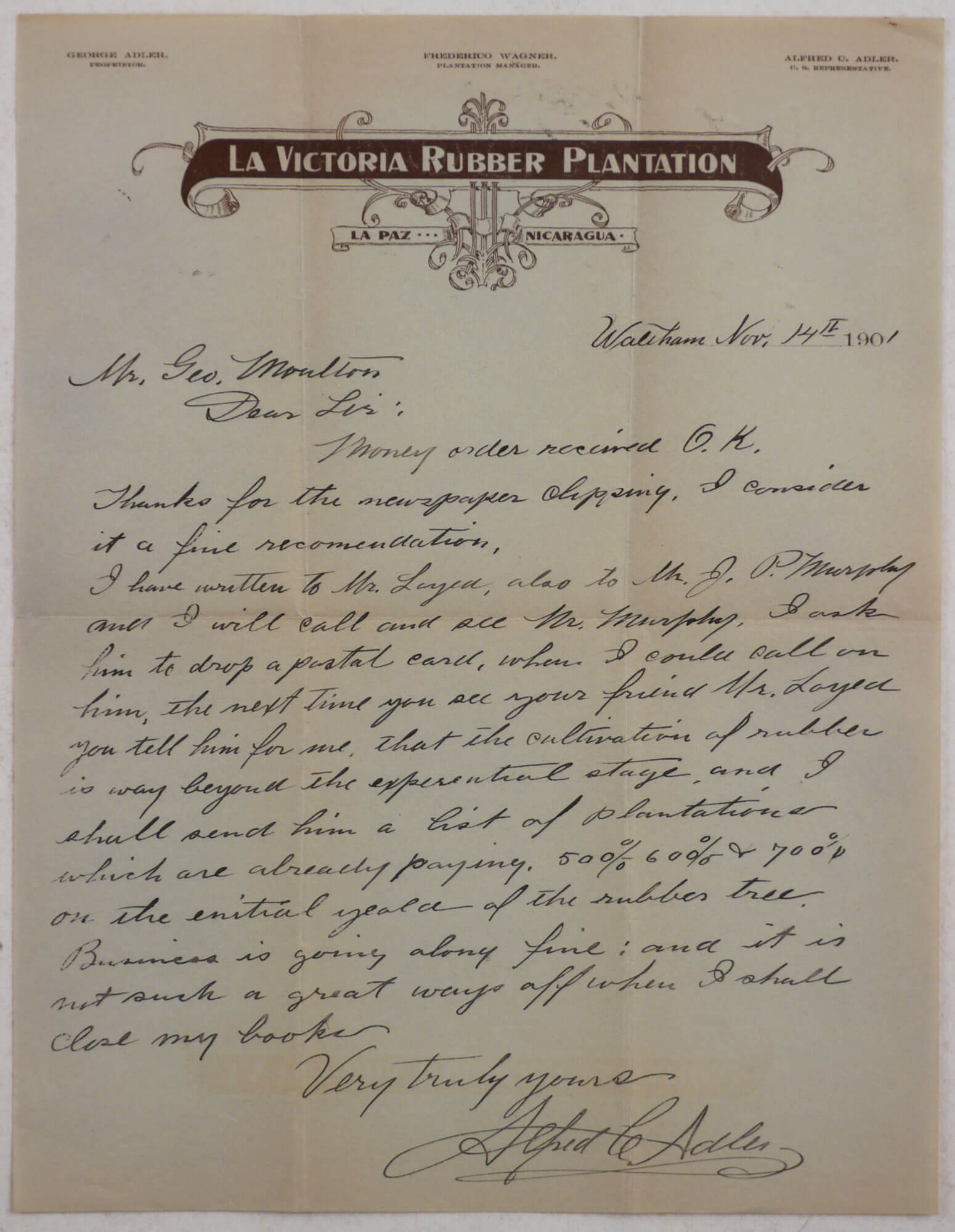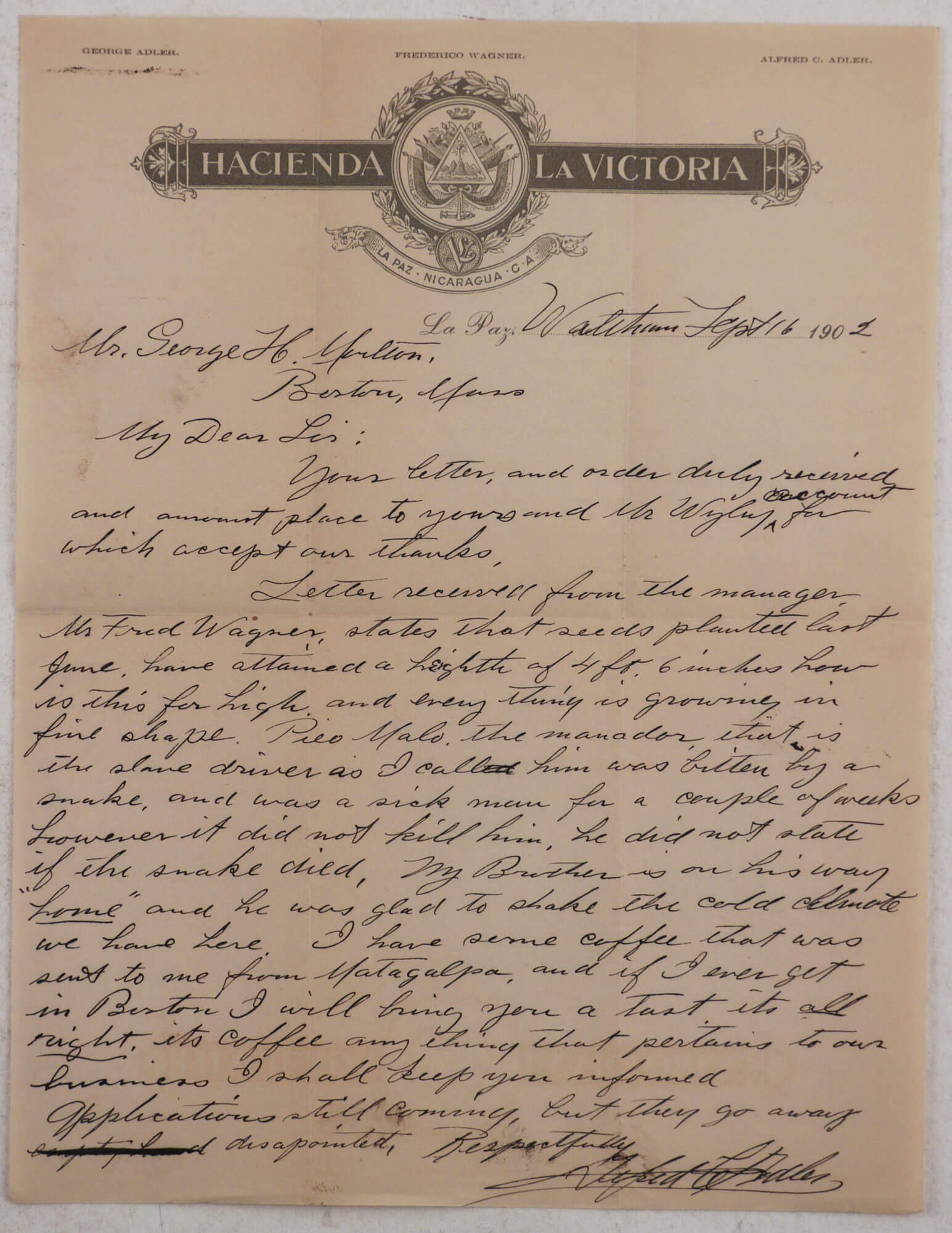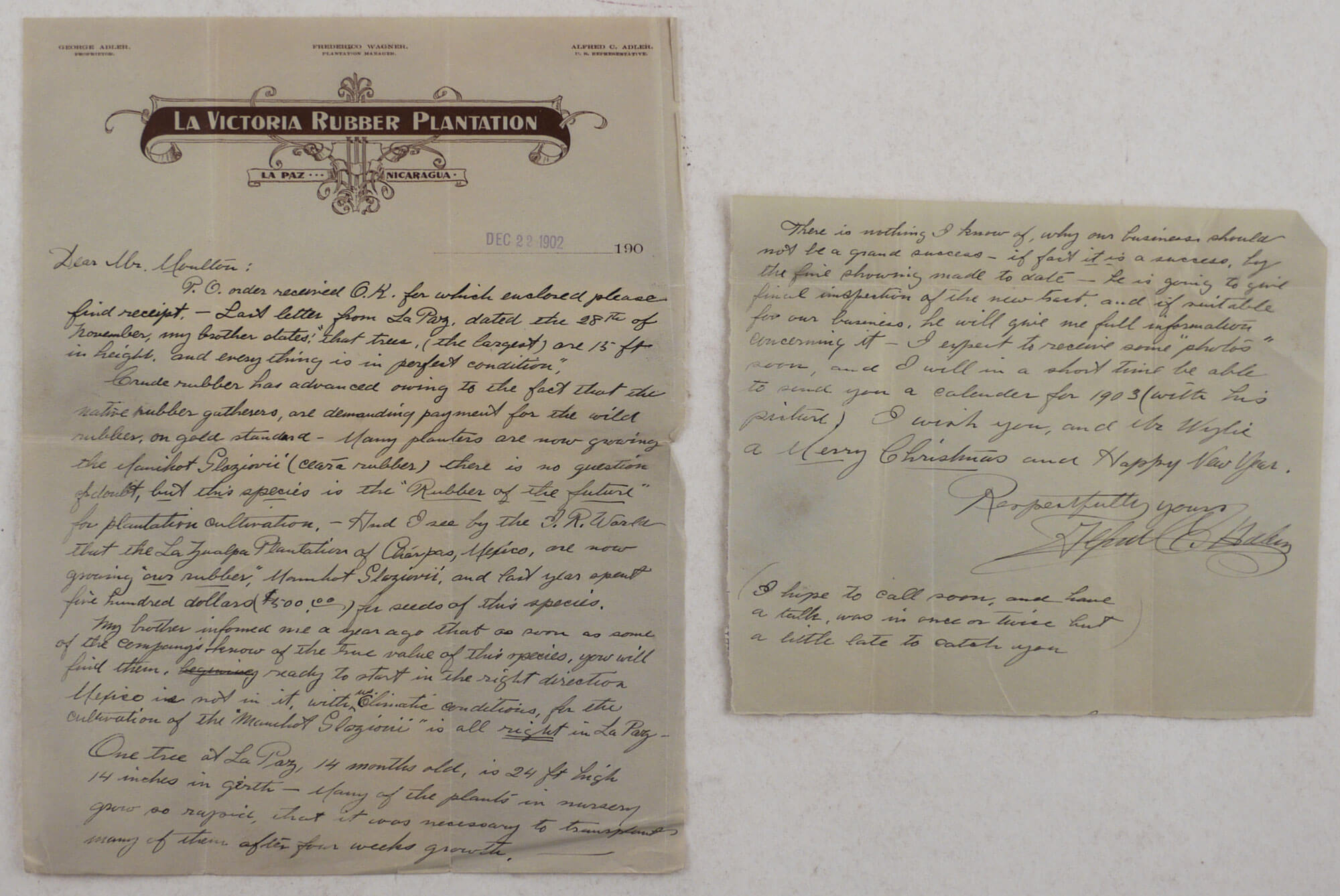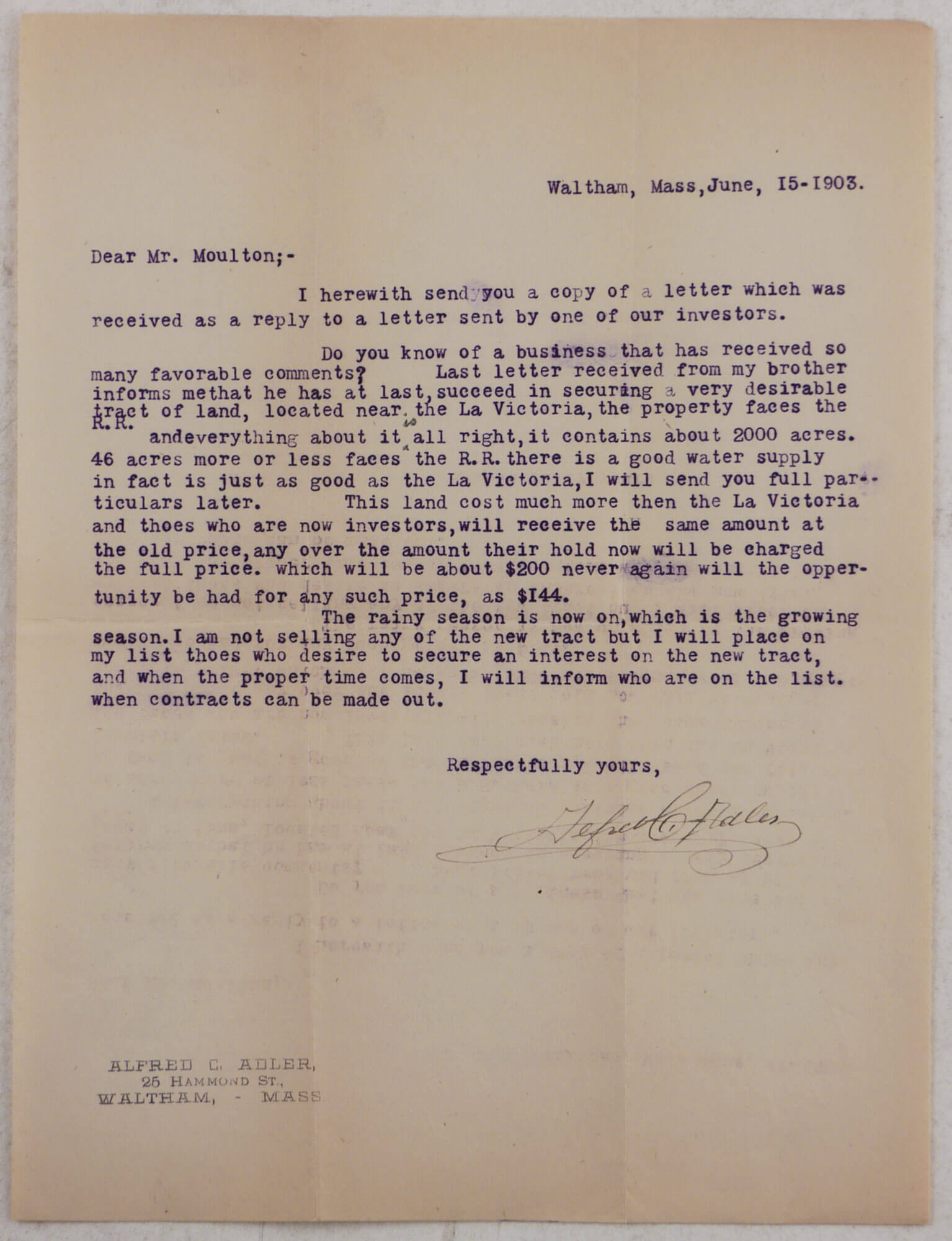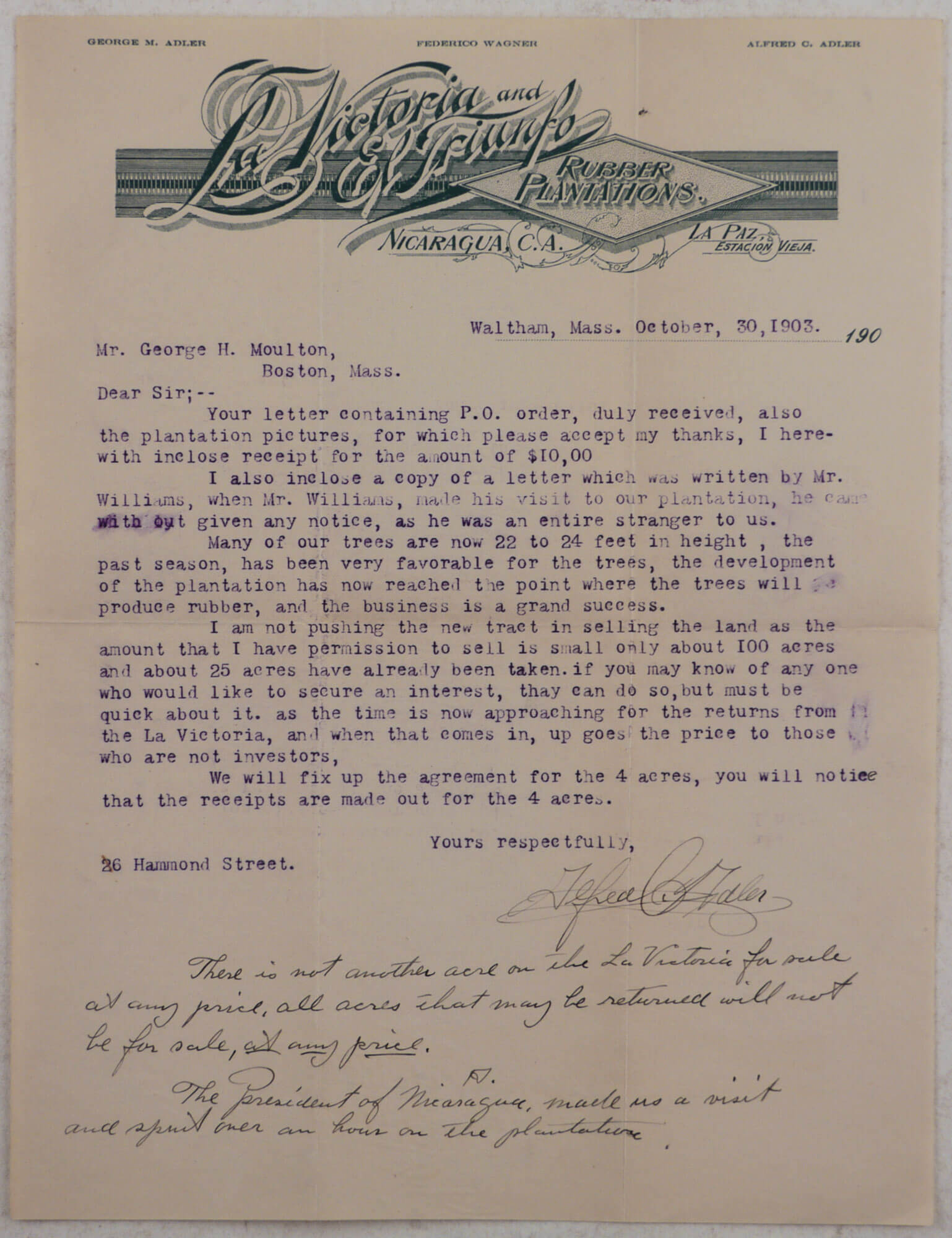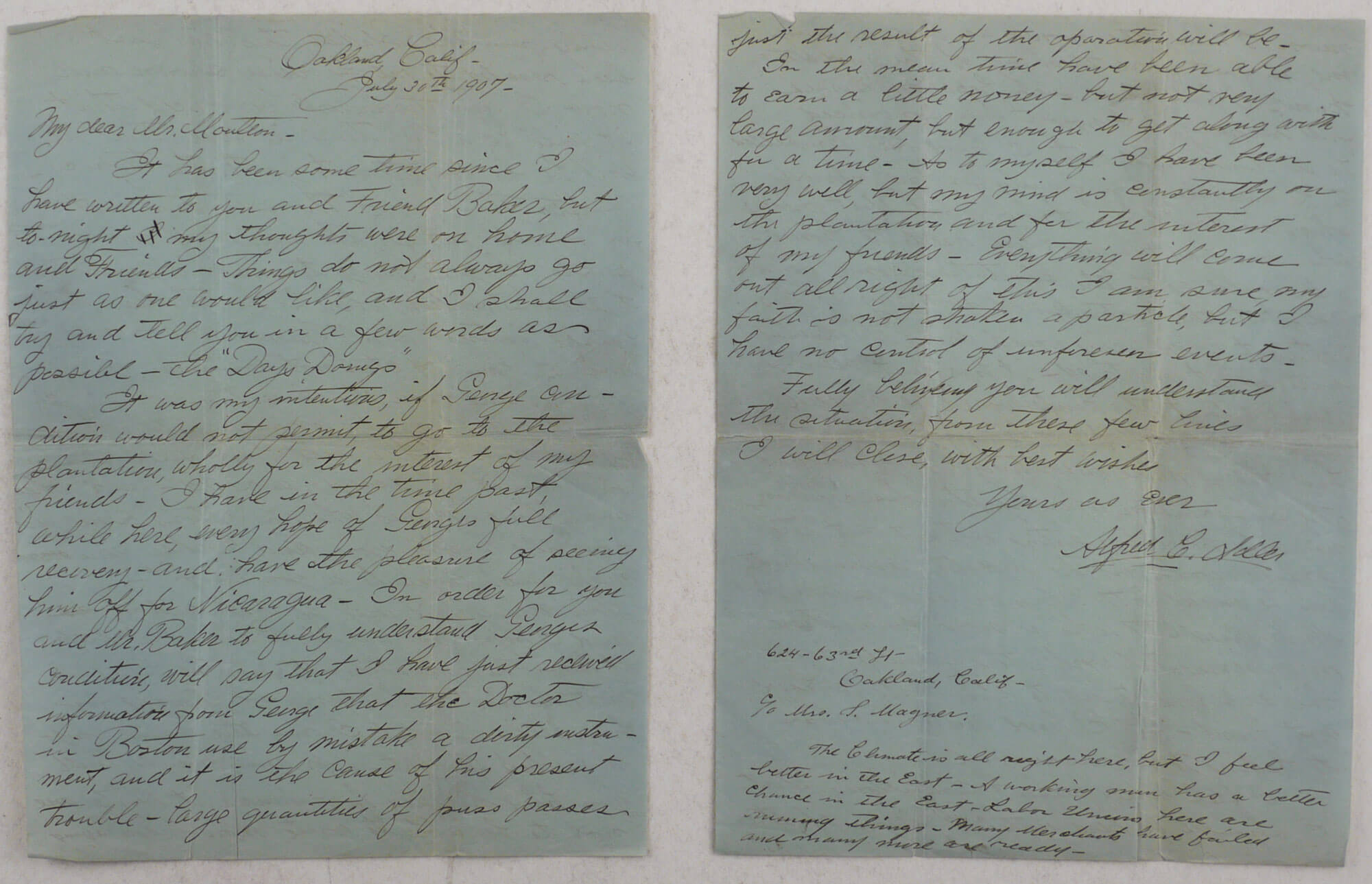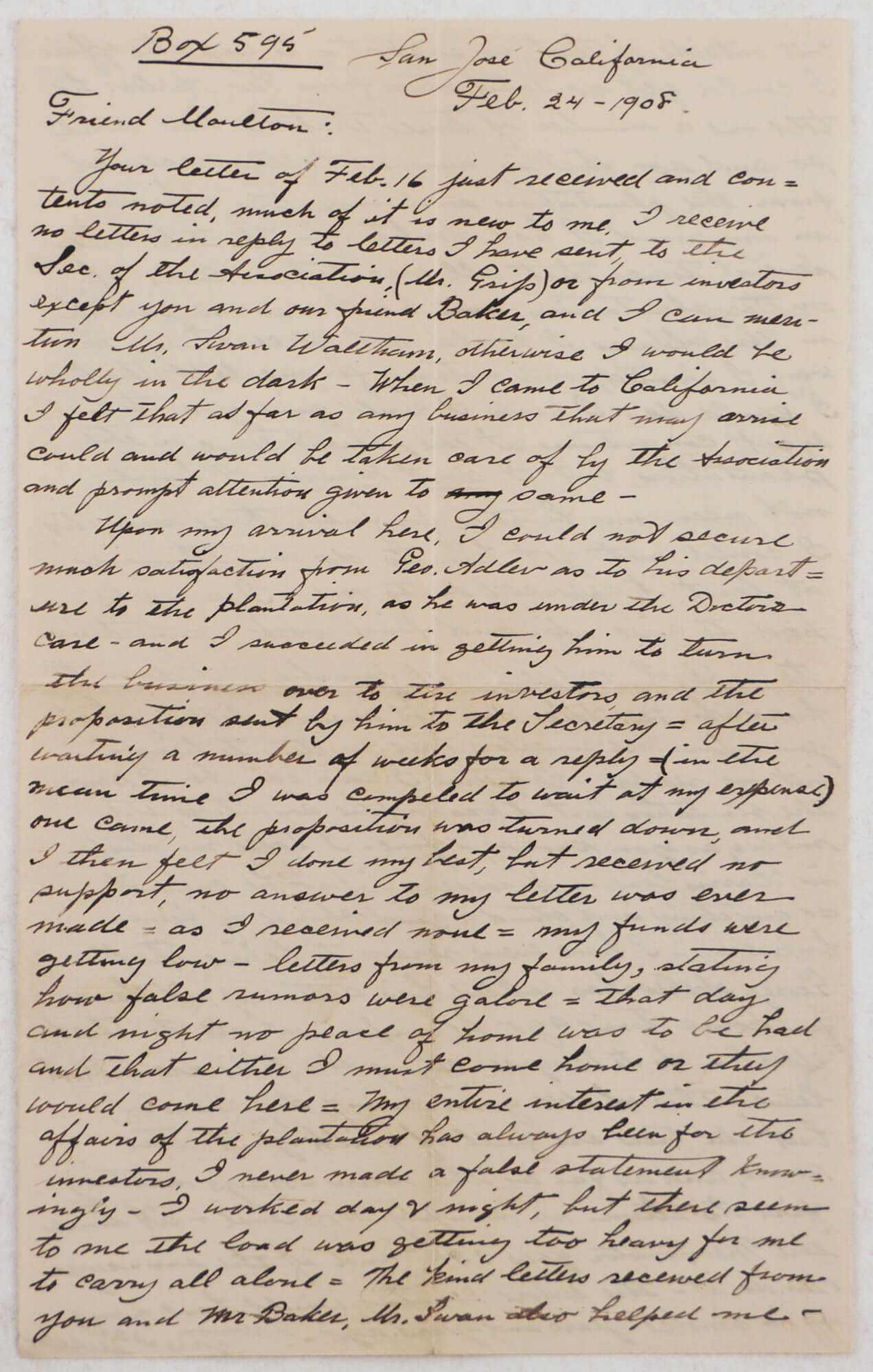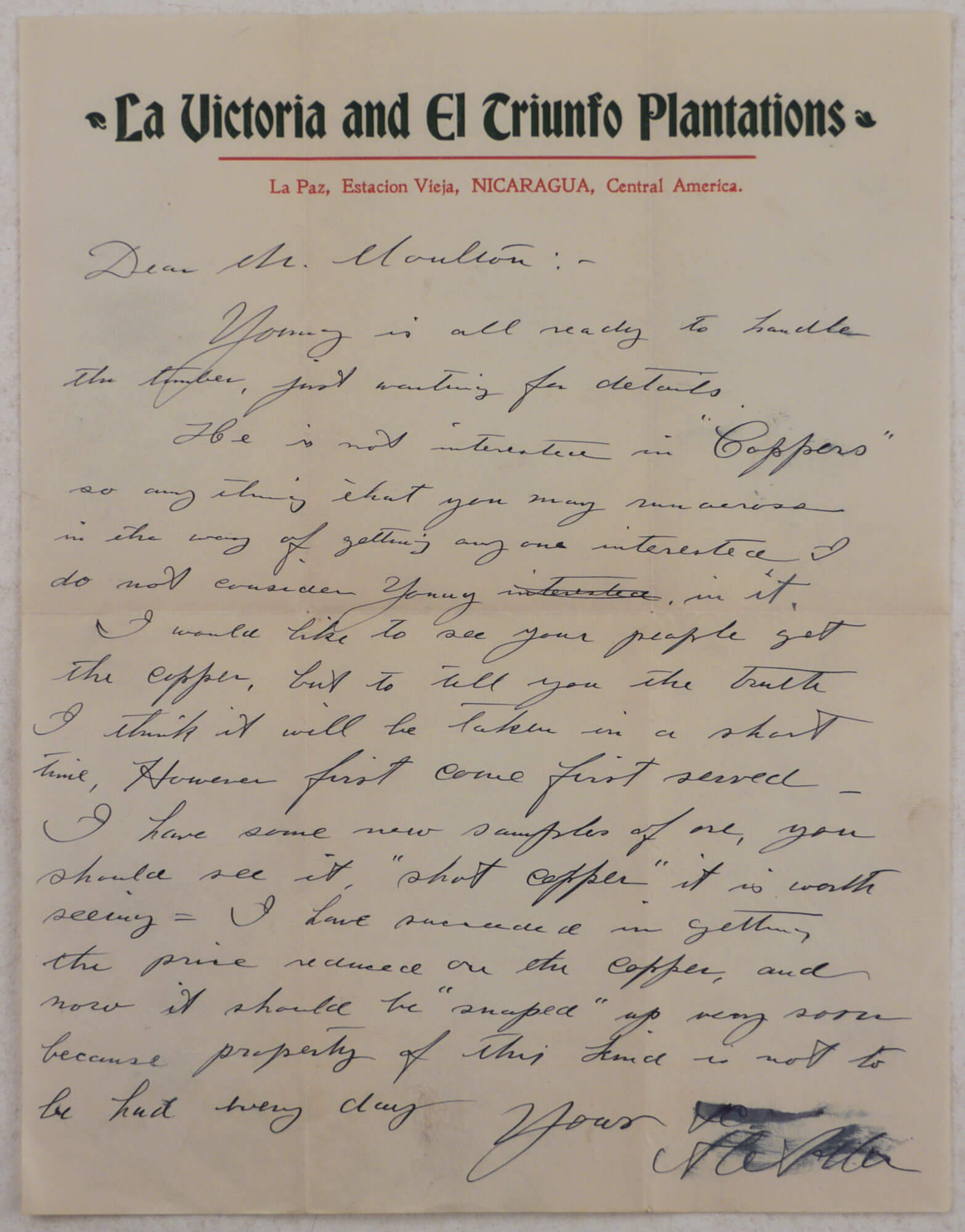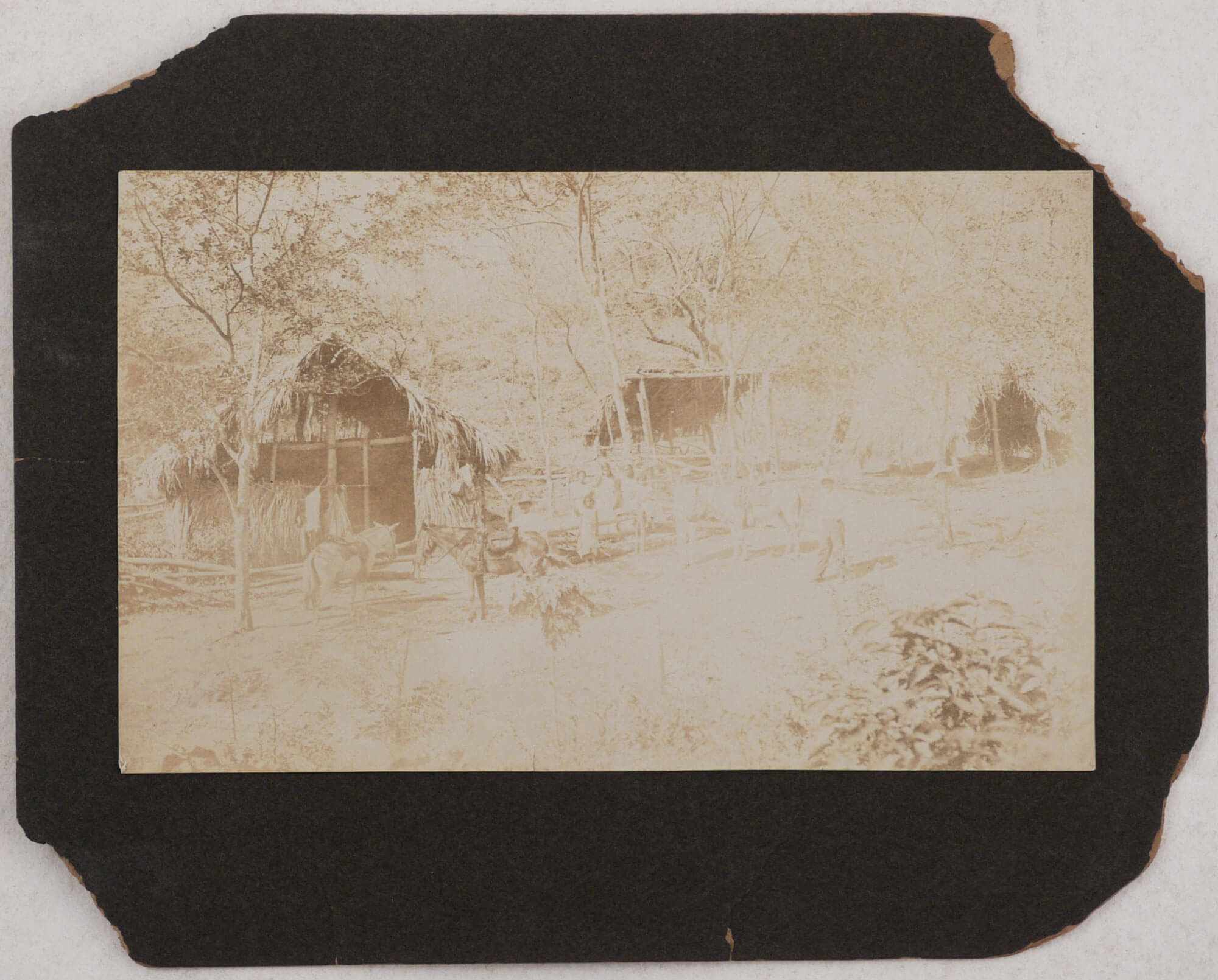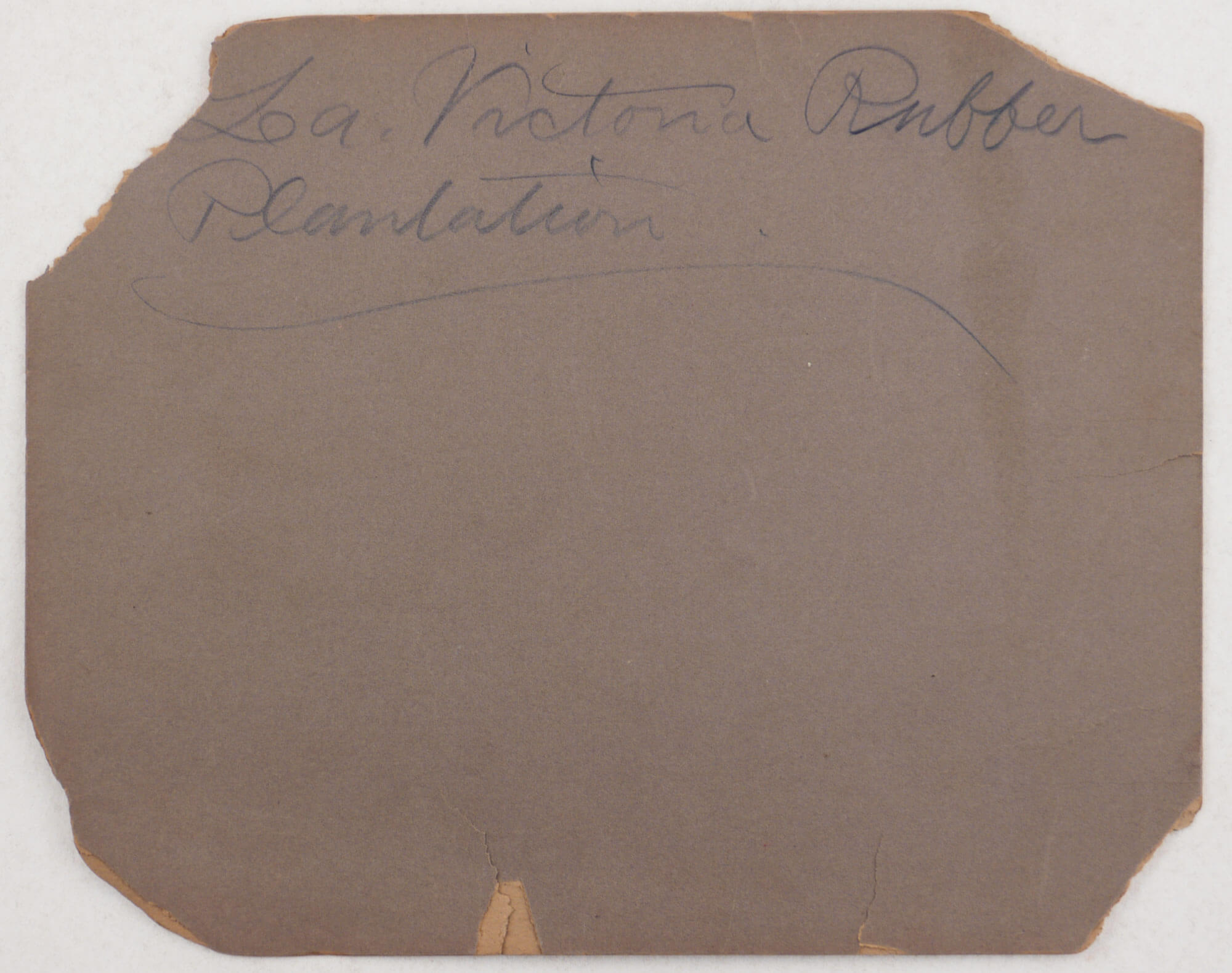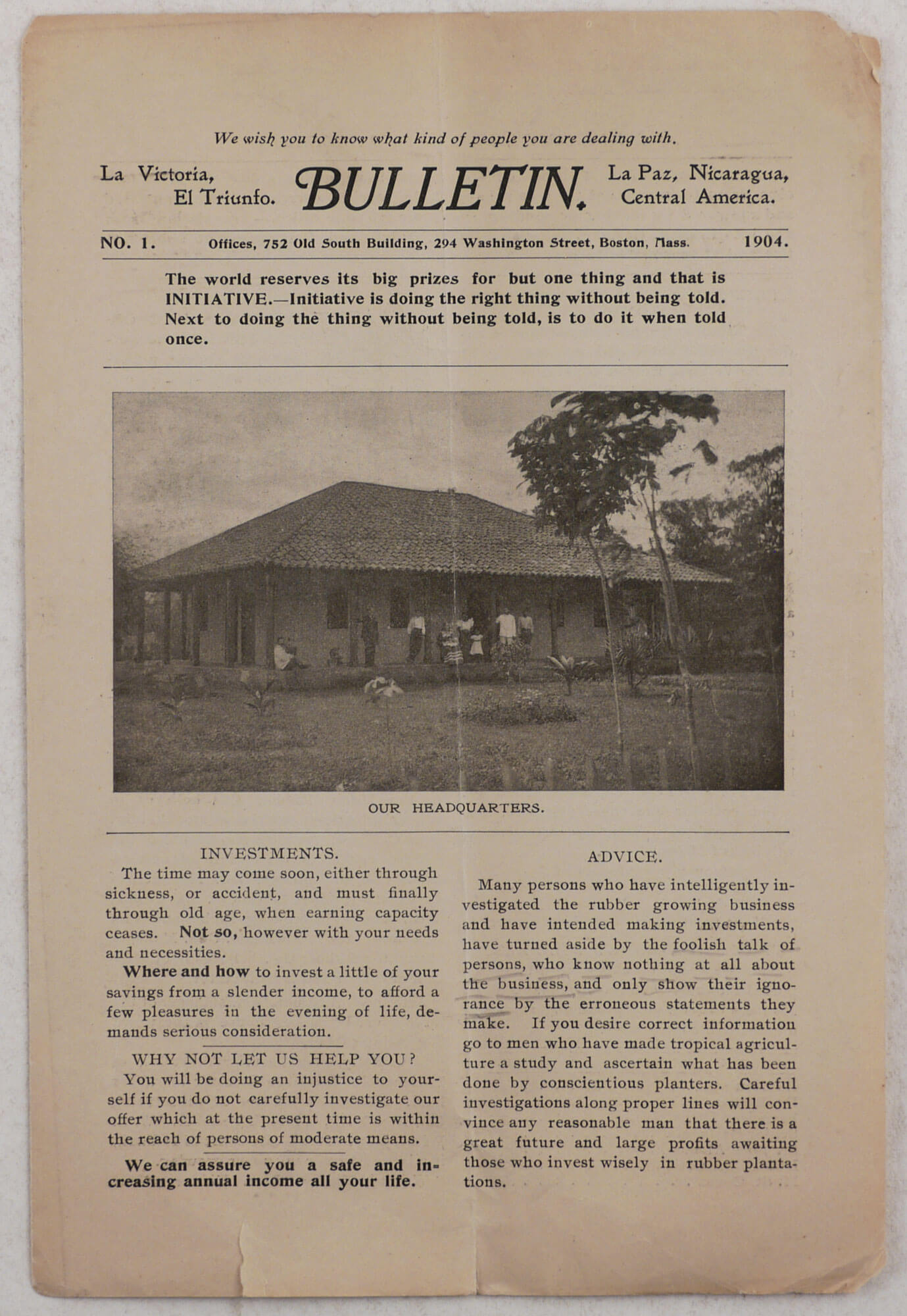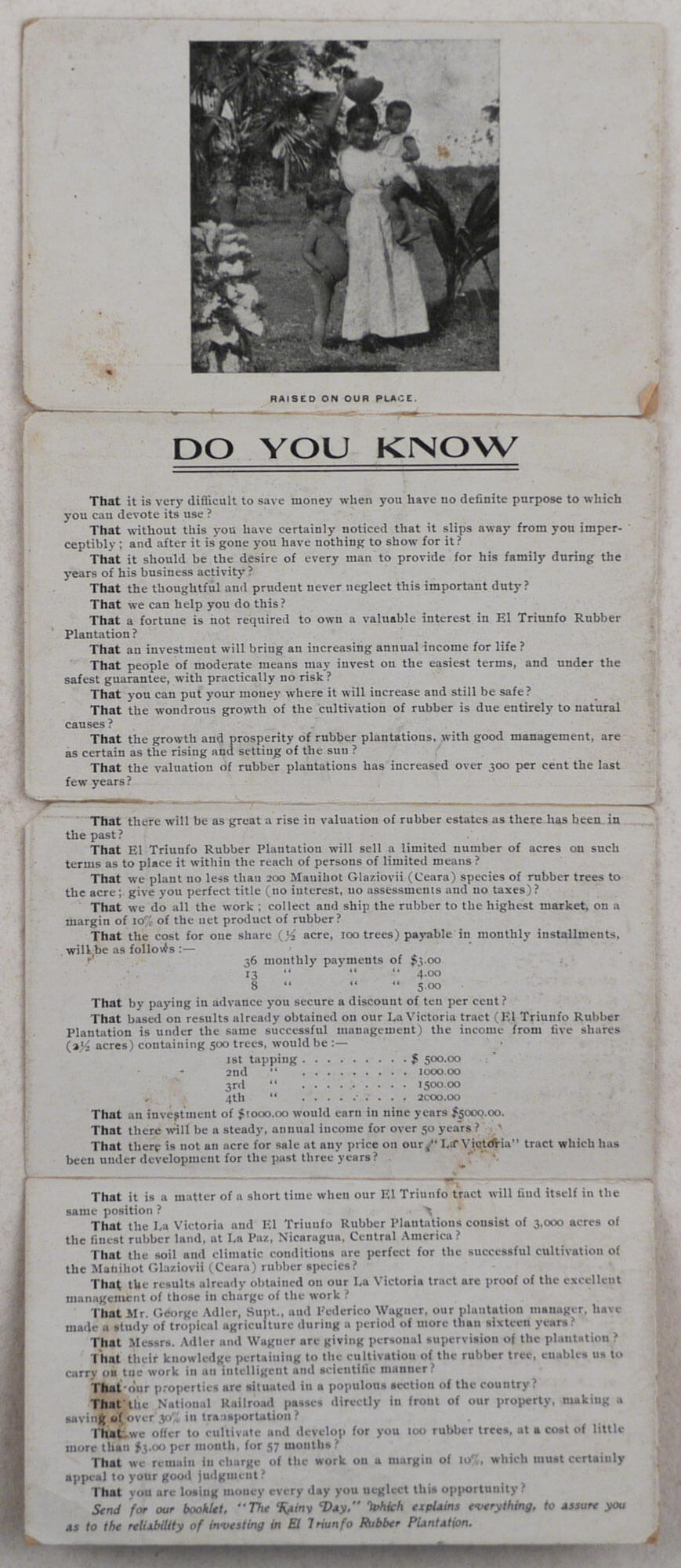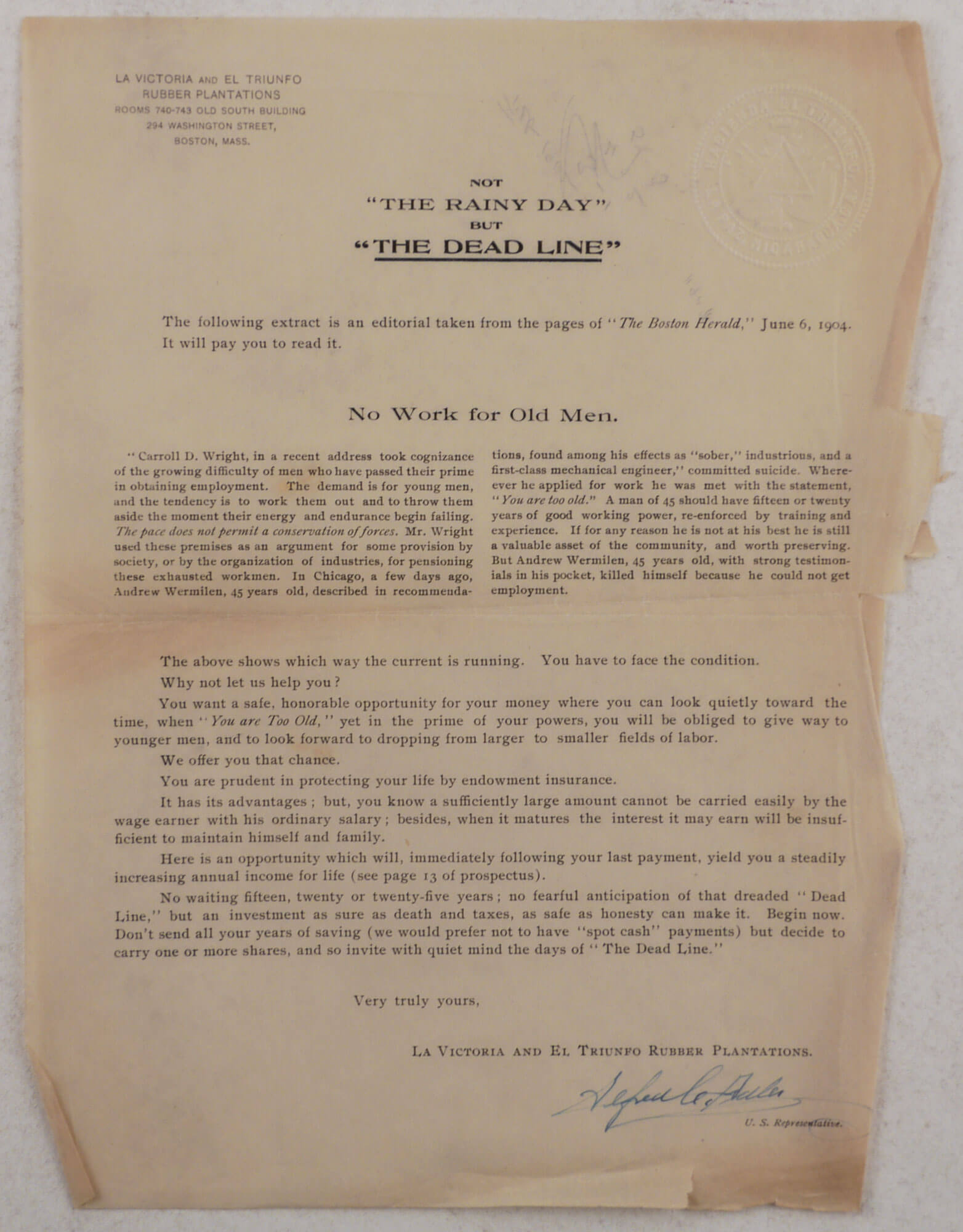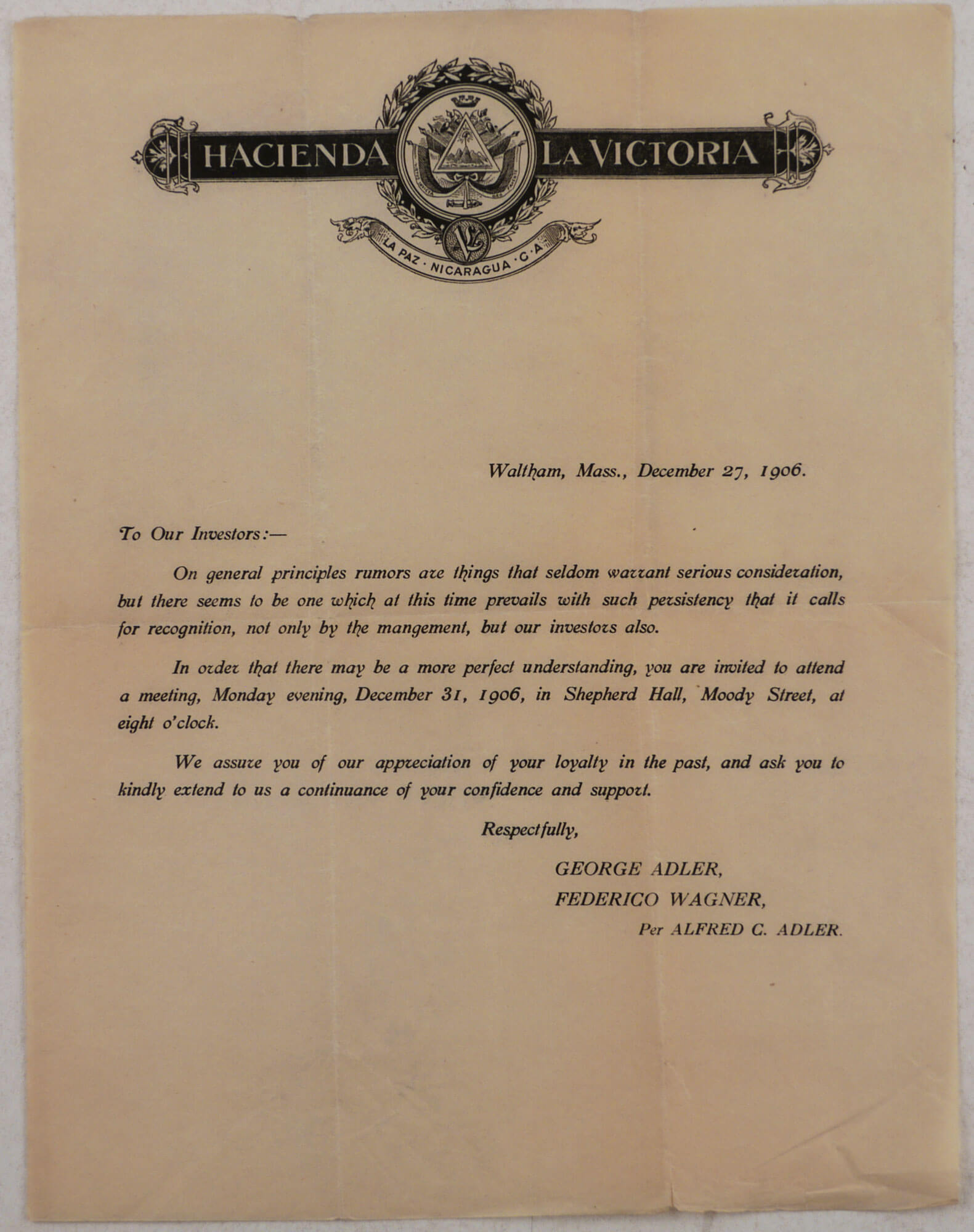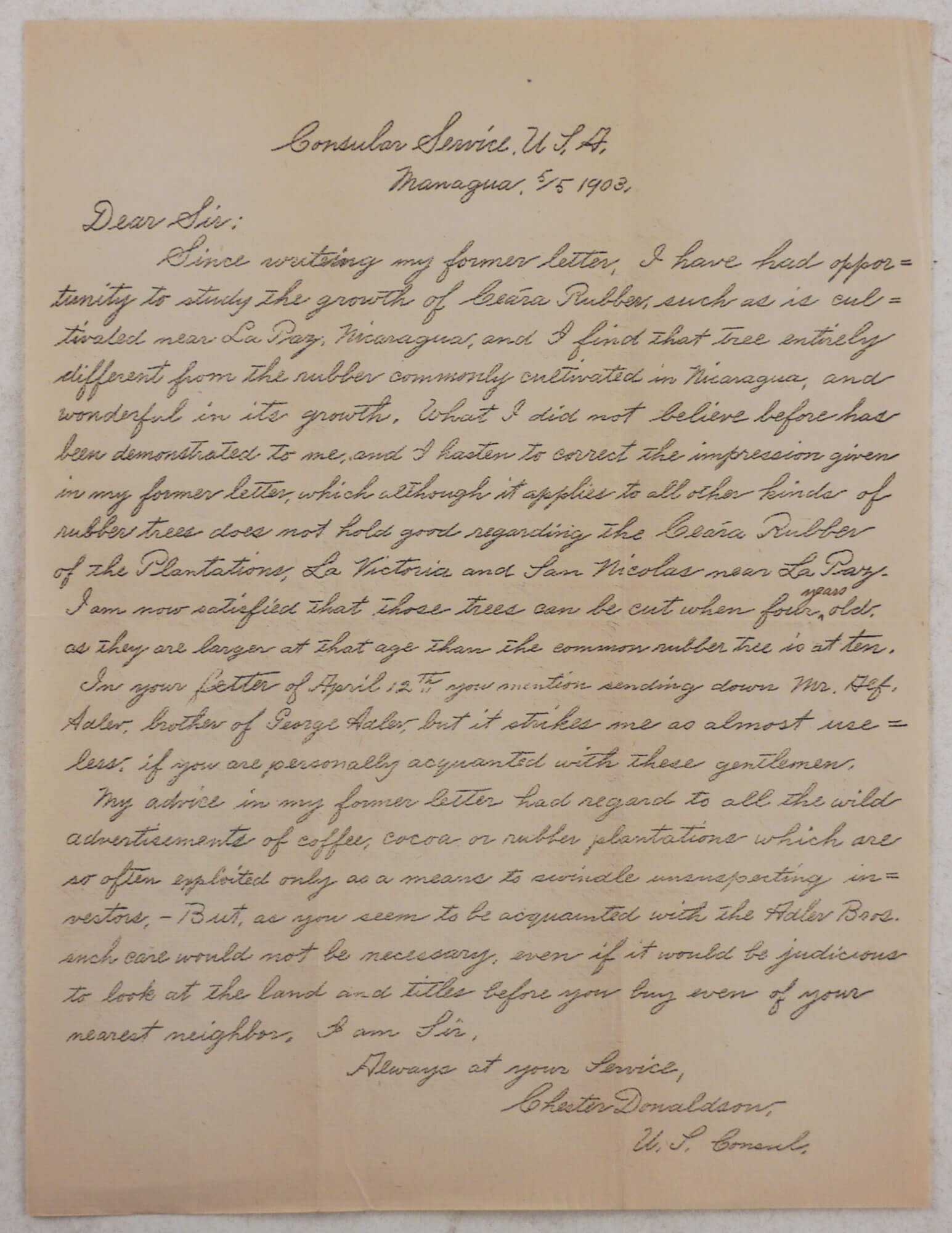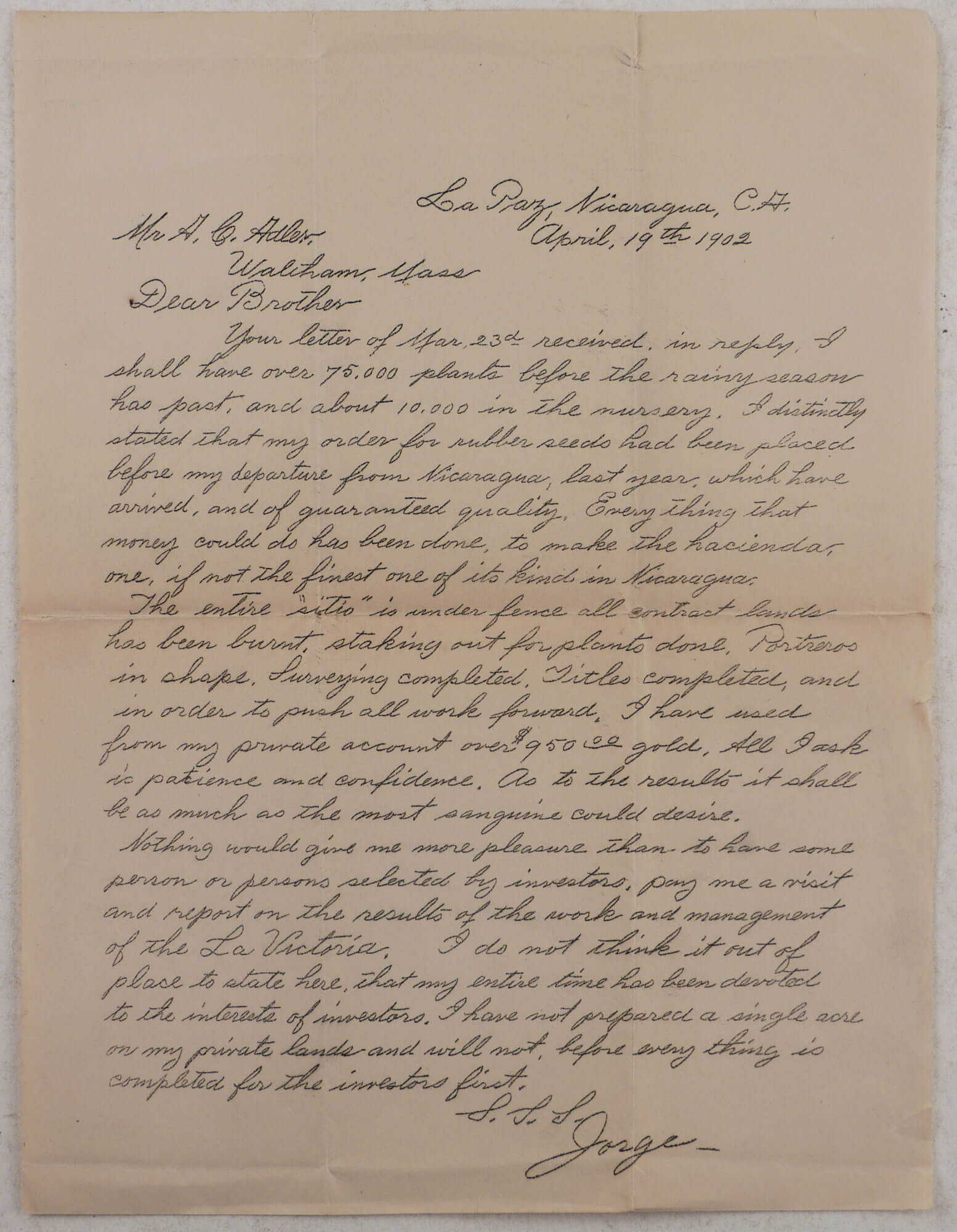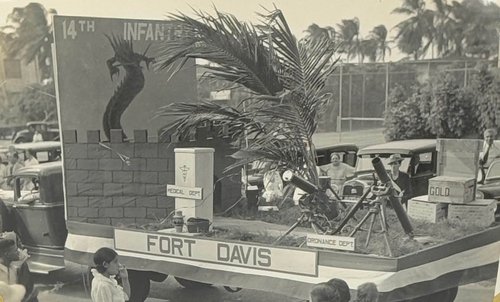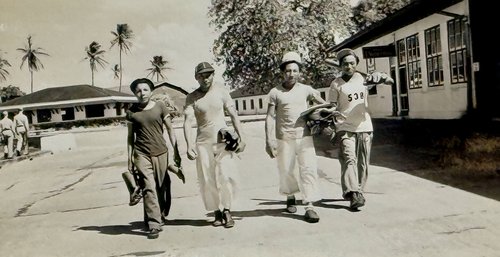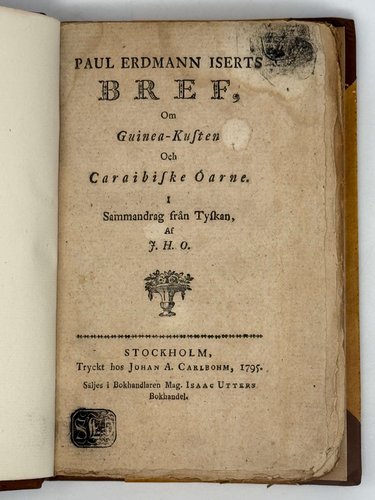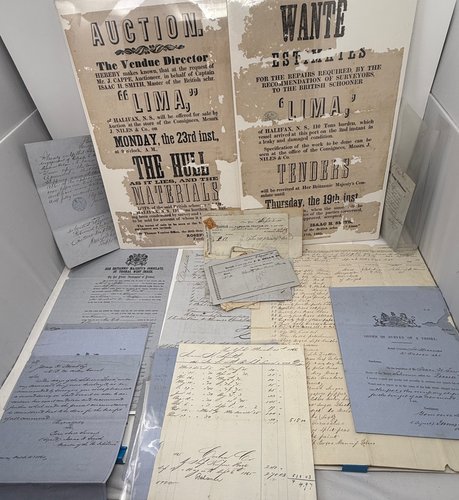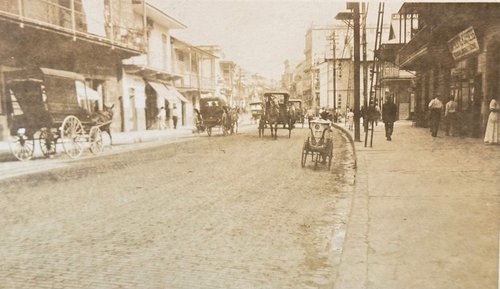

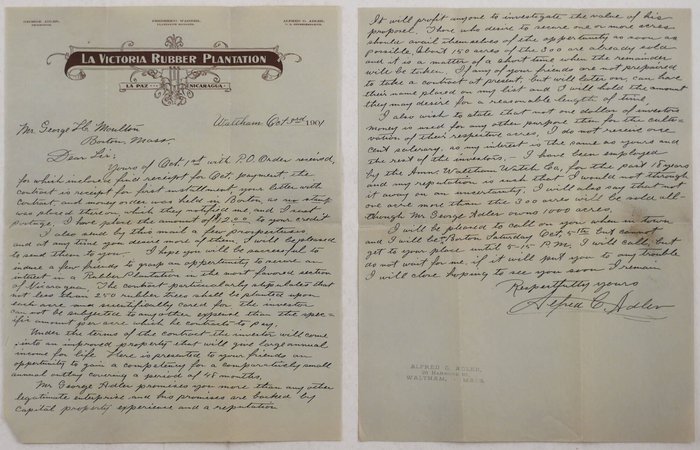
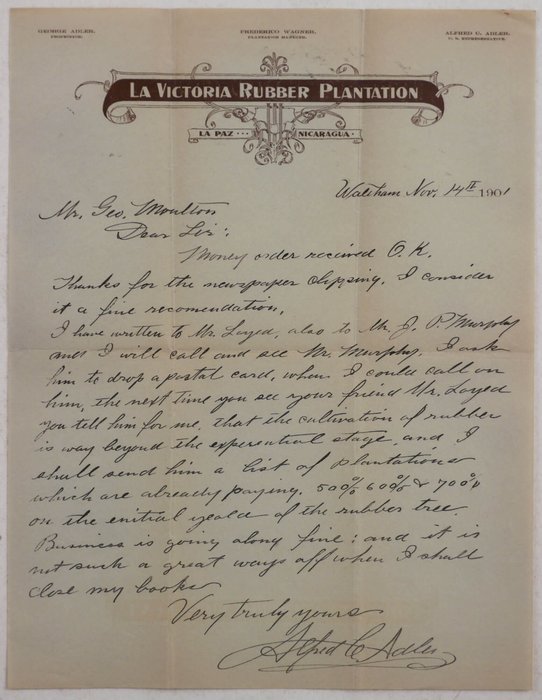
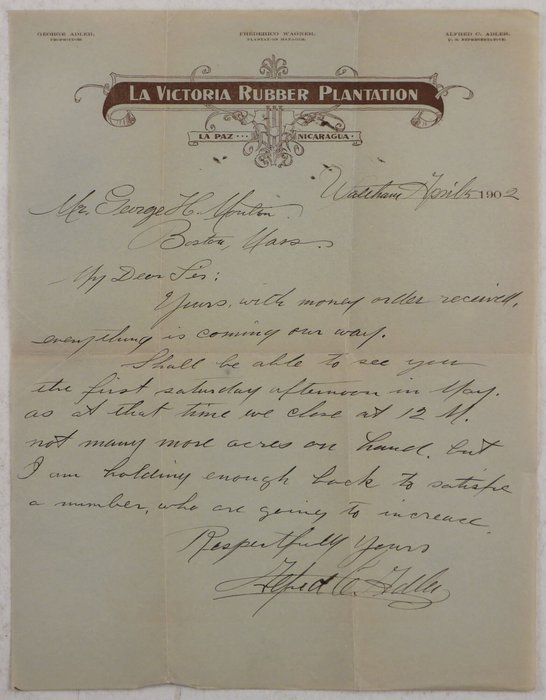
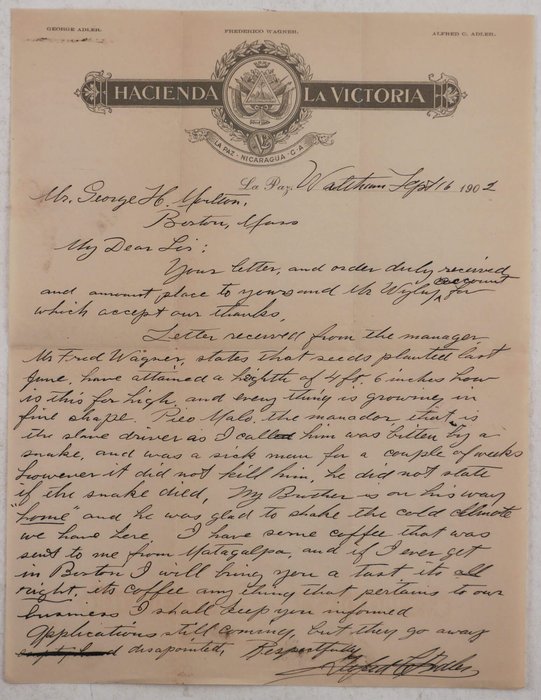

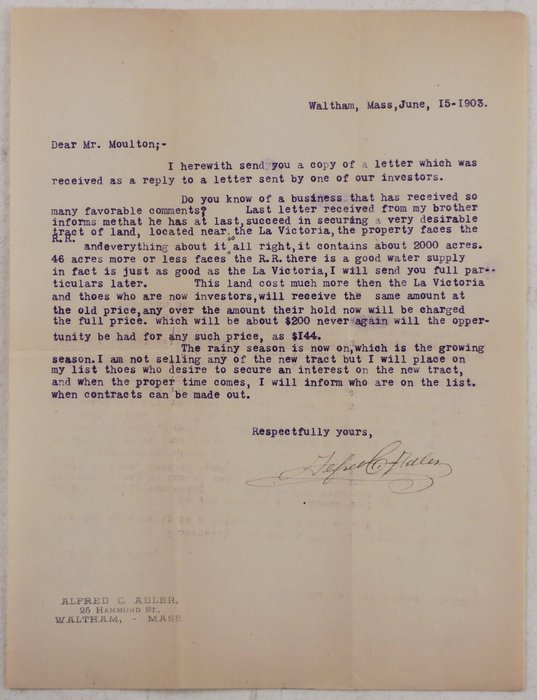

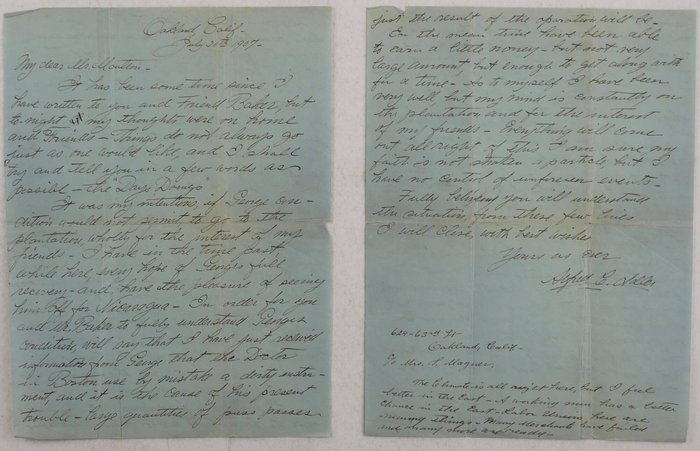
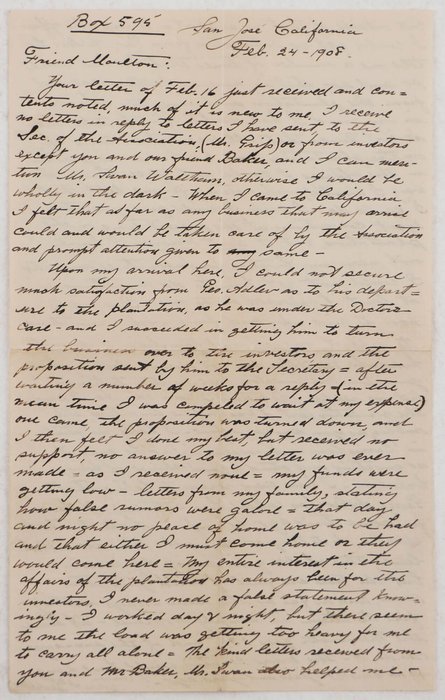
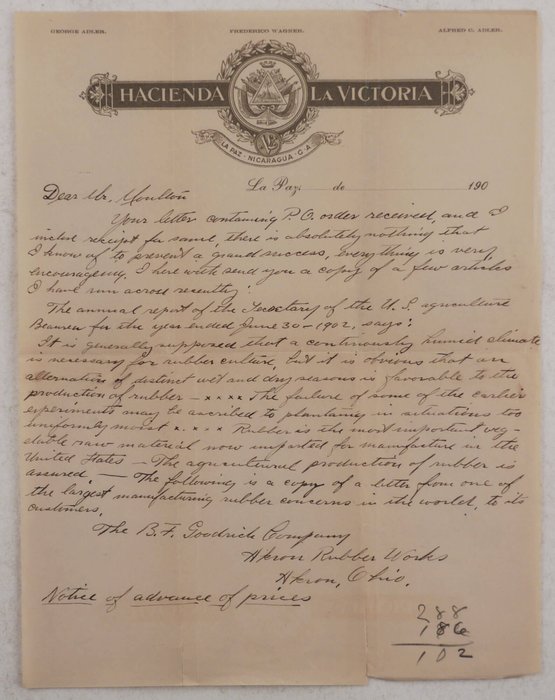

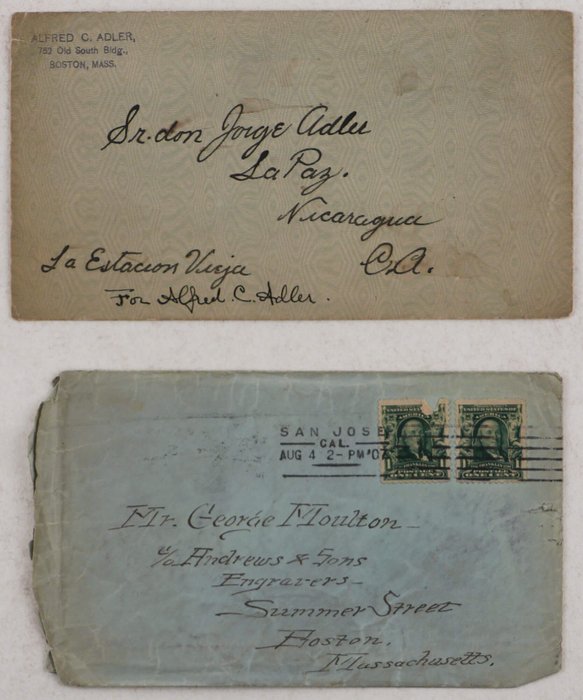
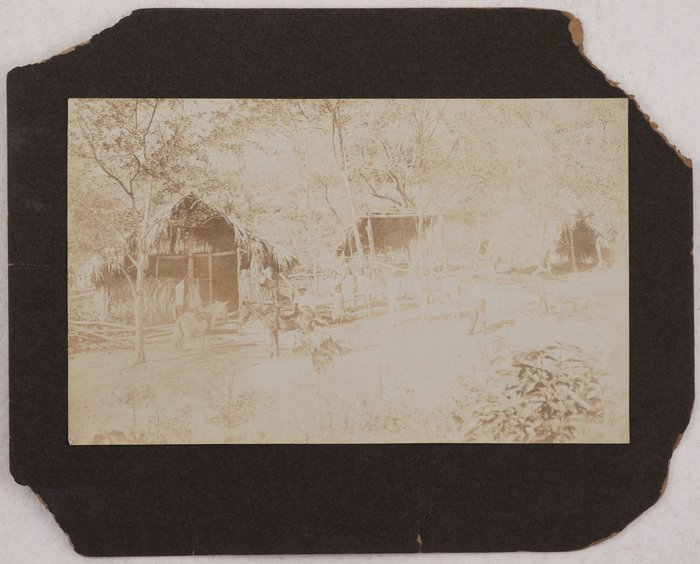
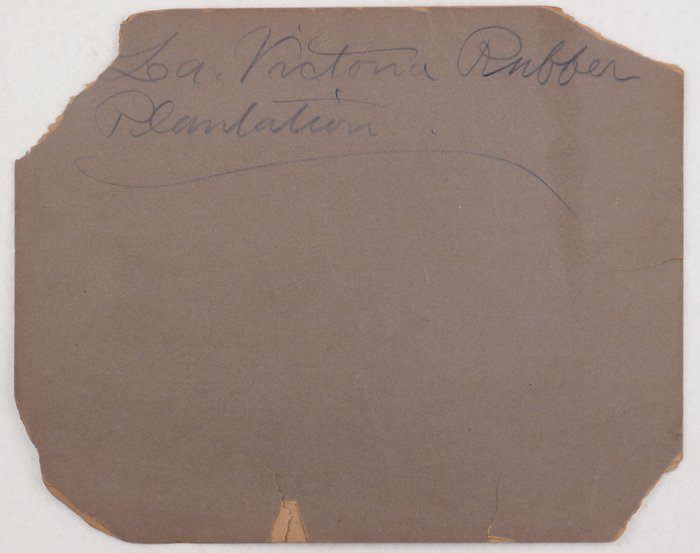

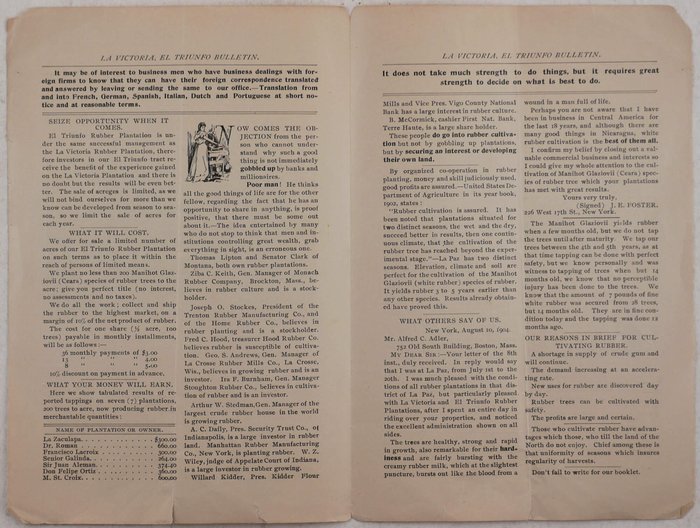
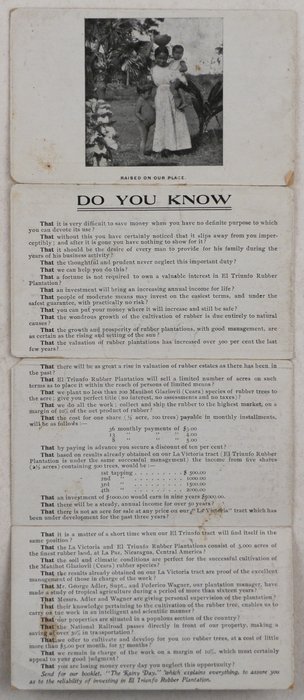
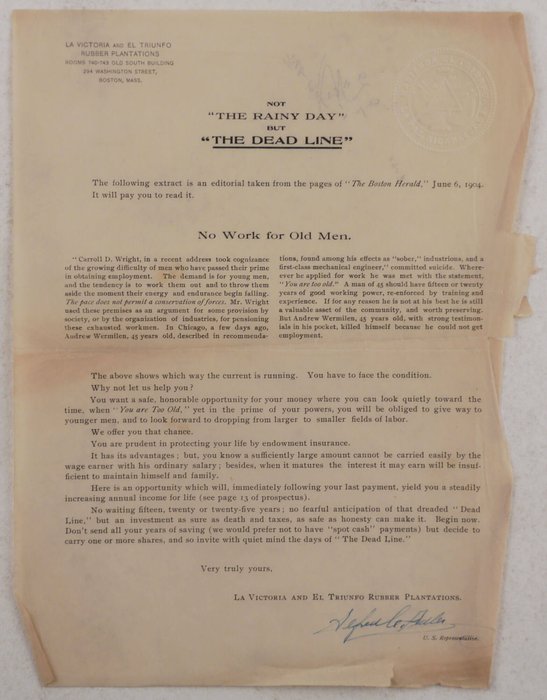
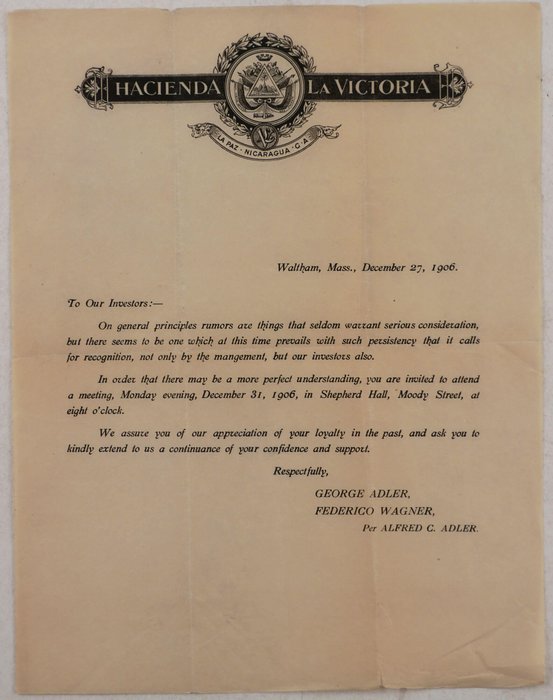

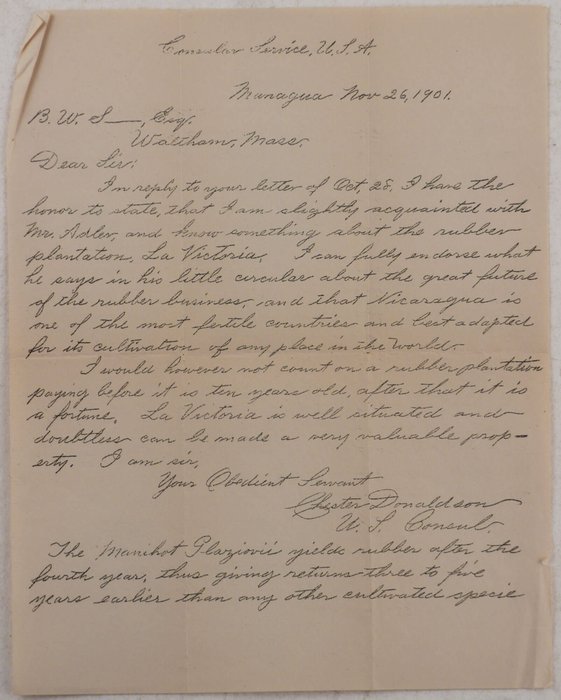


#MA86
Ca. 1901-1908
Twenty autograph letters signed and five typewritten letters signed, from ca. 21,5x28 cm (8 ½ x 11 in) to ca. 20x26,5 cm (8 x 10 ½ in). Black ink on watermarked wove or laid paper. All but four letters with the printed letterheads (“La Victoria Rubber Plantation,” “Hacienda La Victoria,” &c.) or the ink stamps “Alfred C. Adler, 25 Hammond St., Waltham, Mass.” With two original envelopes, addressed to “Sr. don Jorge Adler, La Paz, Nicaragua, C.A.” and “Mr. George Moulton, c/o Andrews & Sons, Engravers, Bummer St., Boston.” With nine mimeographed letters and manuscripts (one in two copies) of similar size. With six original printed promotional leaflets (two in two copies), from ca. 21,5x28 cm (8 ½ x 11 in) to ca. 15x23 cm (6x9 in). In all documents over 50 pp. pf text. With a mounted gelatin silver photo, ca. 12,5x20,5 cm (5x8 in). Fold marks and creases, several documents with tears on the extremities and minor splitting on the folds, the photo is moderately faded; overall a very good archive.
Interesting extensive archive of forty manuscript, typewritten, mimeographed or printed documents, unfolding the history of an unsuccessful enterprise by Massachusetts entrepreneurs to establish a rubber plantation in western Nicaragua in the early 1900s. In 1902, Boston entrepreneur, George M. Adler, purchased one thousand acres of land near the town of La Paz “on the Pacific slope” of Nicaragua, to cultivate Ceara rubber trees (Manihot Glaziovii), native to Brazil. The plot was named “La Victoria Rubber Plantations;” one Frederico Wagner became its manager and Adler’s younger brother, Alfred – its representative in Waltham, Massachusetts. In 1903, George Adler established the second plantation near “La Victoria,” naming it “El Triunfo.” The united company of “La Victoria and El Triunfo Rubber Plantations,” based in Boston (752 Old South Building, 294 Washington Street), carried out an active promotional campaign in Massachusetts to sell shares and land plots on the plantations. The Adlers issued several advertising leaflets and sent articles to the leading American periodical of the rubber industry – “The India Rubber World” (Planting “Ceara Rubber” in Nicaragua// IRW. November 1902, Vol. XXVII, No. 2, p. 57; “Ceara Rubber” in Nicaragua// IRW. December 1902, Vol. XXVII, No. 3, p. 80; Planting “Ceara Rubber” in Nicaragua// IRW. November 1903, Vol. XXIX, No. 2, p. 50; To plant rubber in Nicaragua// IRW. December 1904, Vol. XXXI, No. 3, p. 90). Nevertheless, already in 1906, the Adler brothers had a suit for $30,000 filed against them in Massachusetts by an investor who bought El Triunfo plantation, which turned out not to be developed as he had been promised (Another Rubber Plantation Suit// Boston Evening Transcript. Friday, August 10, 1906, p. 3). In 1909, Alfred Adler was charged with “larceny by false pretences” for selling plantations’ shares and not providing promised dividends but was acquitted by the Waltham Court (Acquitted after all-day trial// Boston Evening Transcript. Saturday, January 2, 1909, p. 5). The plantation business with that, and later records find both Adler brothers in California.
Our collection includes twenty-five original manuscript or typewritten letters, written by Alfred Adler to one of the plantations’ investors, George Henry Moulton. Most letters are dated 1901-1904 and done on good paper with the printed letterheads of the company. Adlers discusses Moulton buying shares, asks him to “induce a few friends to grasp an oppertunity [sic!],” informs that the rubber trees grow well and reassures that “everything is going along in fine shape on the plantation.” Three letters, written in 1907 and 1908 in Waltham and California (Oakland and San Jose), are written on various paper without letterheads and talk about Alfred Adler’s troubles and uncertainty regarding the plantations’ future. There is also a letter written by a representative of the plantations’ Board of Directors after “Alfred Adler has been arrested and is out on bail,” talking about the investors’ intentions to take the criminal case to the Attorney General and prove that “the Adlers knew it was no good while they were taking our money.”
George Henry Moulton was a Boston wood engraver known for his work with the “Boston Globe” newspaper and local engraving firm “John Andrew & Son.” “His portrait work was exceptionally wonderful and he was connected in this capacity with Lester Wallack in Scribner’s Magazine, the illustrations in John Fiske’s histories, the Harvard Graduates’ Magazine and Lamb’s Biography” (Old-time engraver on the Globe passes away// The Boston Globe. July 31, 1921, p. 2).
The mimeographed documents are copies of the letters by Chester Donaldson, U.S. Consul in Managua (dated November 26, 1901 and May 5, 1903), one “R.H. Williams” who “made an unsolicited inspection of the La Victoria Plantation,” addressed to “Mr. G.P. Metzger, Secretary of the Isthmus Commercial Company” (2 copies, dated June 21, 1903), Alfred Adler (May 24, 1902), George Adler (written in La Paz, April 19, 1902), an extract from the report of A.L. Pottschalk, U.S. Consul in San Juan del Norte (dated January 27, 1903), &c. All authors express optimistic views on the future of “La Victoria” and “El Triunfo” rubber plantations in Nicaragua.
The collection also contains rare printed promotional ephemera, related to the rubber plantations, including a four-page “Bulletin, La Victoria, El Triunfo, La Paz, Nicaragua” (two copies), convincing potential investors “to secure an interest in our plantation” (p. 4) and promising “a safe an increasing annual income all your life” (p. 1). The other promotional leaflets are “Not the Rainy Day, but the Dead Line” (with the plantations’ blind stamp and Alfred Adler’s signature) and “Do you know” (with a phototype portrait of a Nicaraguan family). There is also a printed official letter “To our Investors” (dated December 27, 1907), with the first acknowledgement of the company’s troubles (two copies). The gelatin silver photo is a scene with Nicaraguan workers posing next to thatched-roof houses, captioned “La Victoria Rubber Plantation” on verso. Several young rubber tree saplings are visible in the foreground.
Overall an interesting extensive archive of original documents, related to an early attempt of Massachusetts entrepreneurs to establish rubber plantations in Nicaragua.
Excerpts from the letters:
“October 3, 1901.” Dear Sir, Yours of Oct. 1st with P.O. order received for which inclosed [sic!] find receipt <…> I hope you will be successful to induce a few friends to grasp an oppertunity [sic!], to secure an interest in a Rubber Plantation in the most favoured section of Nicaragua. The contract particularly stipulates that not less than 250 rubber trees shall be planted upon such acre and scientifically cared for. <…> I also with to state that not one dollar of investors’ money is used for any other purpose than for the cultivation of heir respective acres. I do not receive one cent salesary, as my interest is the same as yours and the rest of the investors. I have been employed by the Am. Waltham Watch Co. for the past 18 years and my reputation is such that I would not through [sic!] it away on an uncertainty…”
“December 19. 1901 <…> I am more pleased with reports from my brother, and I have disposed of more acres to past week then at any time since July. <…> I have sold 10 acres to one of the highest official of the Amn. Watch Co., and it has started a great many others to come in…”
“Sept. 16, 1902. Letters received from the manager, Mr. Fred Wagner, states that seeds planted last June, have attained a height of 4 ft 6 inches, how is this for height, and everything is growing in fine shape. Pico Malo, the [manador?], that is the slave driver as I call him, was bitten by a snake, and was a sick man for a couple of weeks. However, it did not kill him.”
“November 15, 1902. <…> This month “India Rubber World” has an article on the cultivation of rubber in the La Victoria. It’s all right, would like have you read it <…>. One of our investors died, and before the poor fellow was buried, I have several application for the interest he had…”
“December 22, 1902. Last letter from La Paz, dated the 28th of November, my brother states that trees (the largest) are 15 ft in height and everything is in perfect condition…”
“February 29, 1904. I have received several letters from my brother, and also three photographs, showing the trees as they are today. I was very much surprised with the results show in the photos. I did not expect to see the trees so large <…> My brother says: “There will be no failure of production of rubber, the trees contain now a large quantity of milk, and the Latax with rubber of a superior quality, far superior to any species planted or wild in any other of the Central American Countries. Also arrangements is being made whereby we shall secure a new railroad station, directly in from of the El Triunfo…”
“July 30th, 1907. <…> I have just received information about George that the doctor in Boston use by mistake a dirty instrument, and it is the cause of his present trouble – large quantities of puss passes daily from the blader, this has just been reveiled [sic!] to me, by being shown, and no I am througherly [sic!] convinced that it will be a long time if ever that he will be in condition to go to the tropics… <…> I had George make in writing a proposition to the Association, whereby the Association not only have his entire interest but the acreges [sic!] owned by the investors, arrangements can be made with Wagner…”
“Feb. 24 – 1908. San Jose, California <…> Upon my arrival here, I could not secure much satisfaction from Geo. Adler as to his departure to the plantation, as he was under the doctor’s care, and I proceeded in getting him to turn the business over to the investors <…> My entire interest in the affairs of the plantations has always been for the investors. I never made a false statement knowingly. I worked day and night, but there seem to me the load was getting too heavy for me to carry all alone. <…> I could get no satisfaction from Geo. Adler, he told me a number of times that he had done so and so, that is, answer letters received from the plantation and investors, which in my mind I had doubts of. He told me several times that all was taken care of on the plantation. <…> I have not seen my brother for fully three months <…> As to Wagner saying the trees are without leaves, this […?] good during dry season, but the trees are full of milk just the same, and as far as the sun rays setting fire to them, is simply nonsense. At times the thermometer goes 135° and if the sun rays can do it, the entire county would have gone up in smoke years and years ago…”

